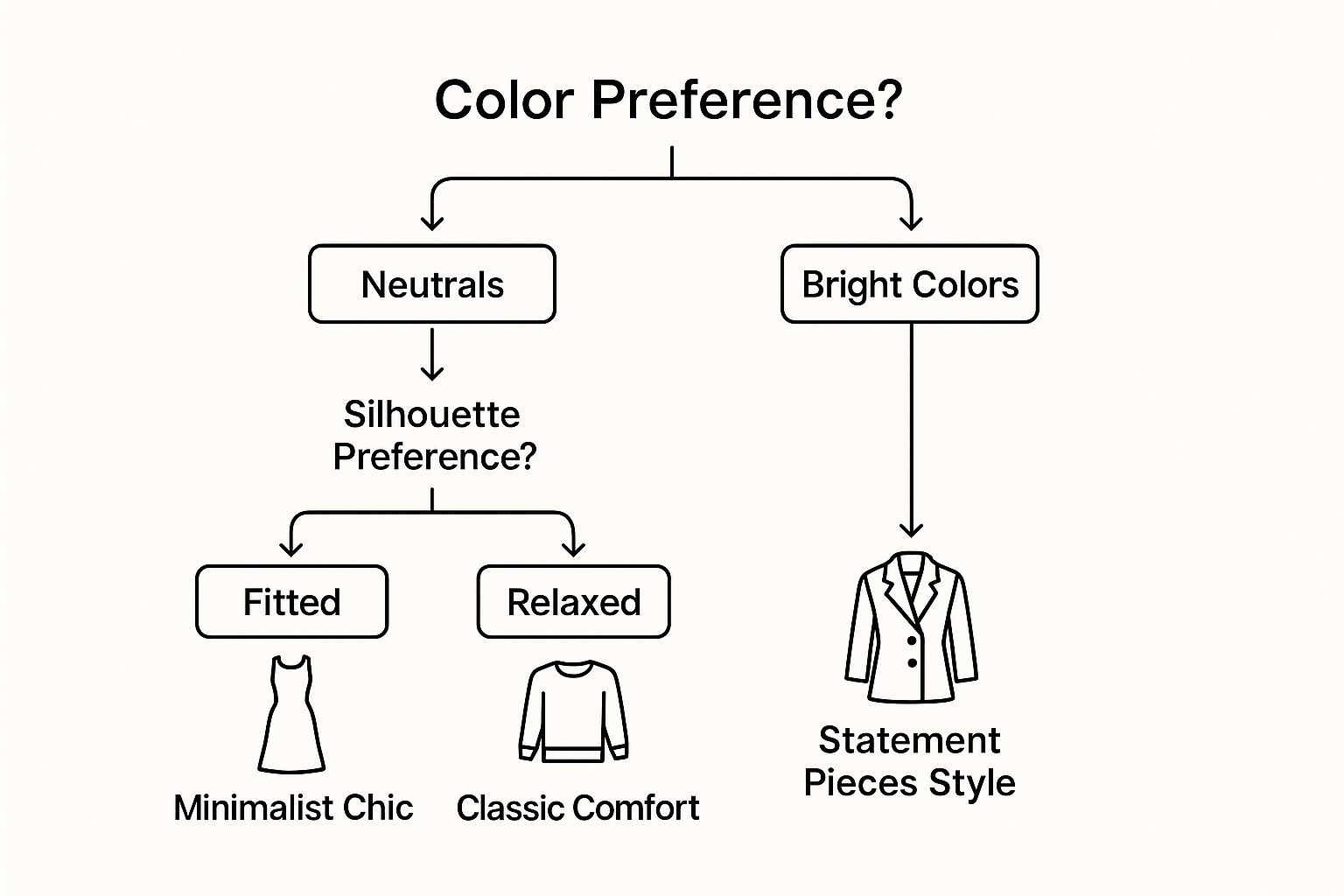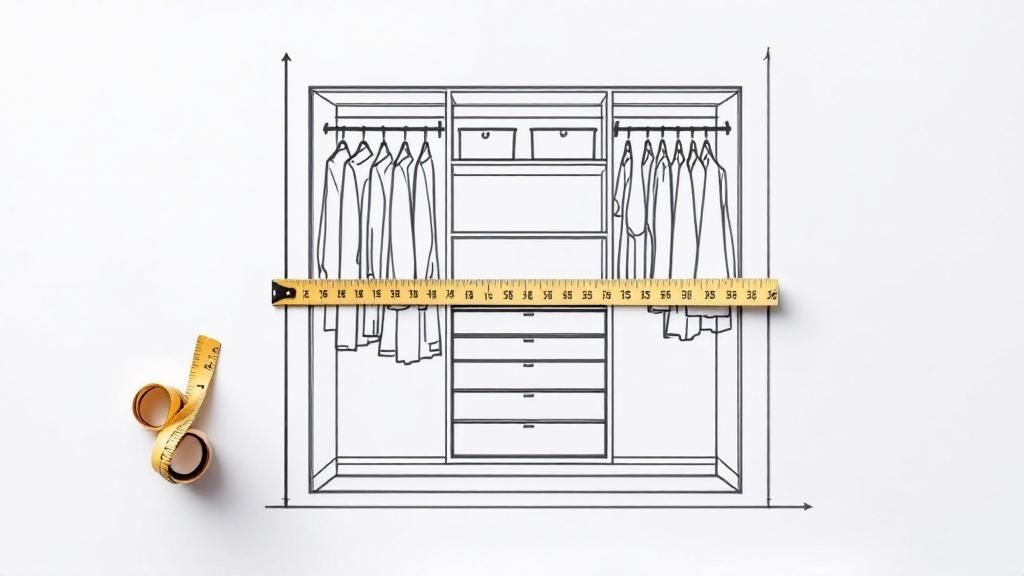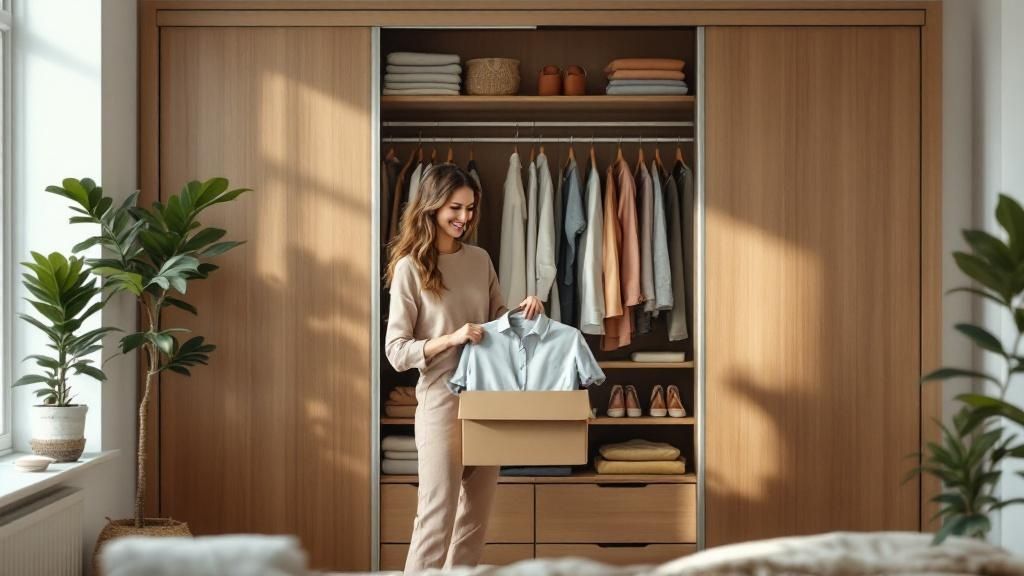Why Your Closet Edit Changes Everything
If you’ve ever stood in front of a wardrobe packed with clothes, yet felt like you had absolutely nothing to wear, you know the feeling of decision fatigue all too well. It’s a frustrating cycle: a closet full of options that somehow leaves you feeling stressed and uninspired every single morning. The usual reaction is to go shopping, but adding new pieces to a chaotic closet rarely fixes the root of the problem.
Learning how to edit your closet is about so much more than just tidying up. It's a thoughtful process that brings clarity and purpose back into your daily routine. By making mindful cuts, you can elevate your entire collection and, in turn, your confidence. This shift from simply collecting clothes to carefully curating them is why the closet organization industry is thriving. The market is expected to grow from USD 7.64 billion in 2024 to USD 8.31 billion in 2025, a clear sign of our collective desire for more functional and orderly living spaces. You can explore more about the rise of home organization to see how this trend reflects our changing priorities.
The Real Difference Between Organizing and Editing
It’s important to understand that organizing and editing are not the same thing. Think of it like this: organizing is like shuffling papers on a cluttered desk. You might stack them neatly or color-code them in folders, but the same volume of stuff is still there. It looks better for a moment, but you haven't actually dealt with the core issue.
Editing, on the other hand, is the act of going through those papers and deciding what you truly need. It involves making deliberate choices about what serves you and what's just taking up valuable physical and mental real estate.
An effective closet edit delivers a few key results:
- Reduces Daily Stress: With fewer, better choices, you'll spend less time debating what to wear and more time feeling fantastic in your final selection.
- Defines Personal Style: By clearing out the "noise," you can finally see the pieces that truly represent you, which makes building a cohesive look much easier.
- Maximizes Versatility: You’ll start to see how your favorite items can work together in new combinations, unlocking outfits you never even knew you had.
- Promotes Mindful Consumption: When you understand what you own and love, you become a much smarter and more intentional shopper down the line.
From Wardrobe Stress to Effortless Style
Many people I've worked with describe the feeling after a successful wardrobe edit as liberating. I’ve seen clients go from a state of constant, low-level anxiety about their clothes to dressing with an ease and confidence they never thought possible. The goal isn't to deprive yourself; it's to empower yourself.
By thoughtfully curating your collection, you’re doing more than just creating a functional closet—you’re designing a more streamlined and stylish start to every single day. The process gives you back your time, energy, and a renewed sense of self.
Taking Inventory Without the Overwhelm
The idea of pulling every single thing out of your closet at once is a popular, yet often paralyzing, piece of advice. Instead of creating a mountain of clothes on your bed that triggers instant decision fatigue, let's try a more manageable approach. The first step in learning how to edit your closet is to see what you’re actually wearing without drowning in choices. You’ll be surprised how much clarity this simple shift can bring.
Start with Your Heroes
Before you touch anything else, pull out only the pieces you absolutely adore and wear constantly. These are your wardrobe heroes—the go-to jeans that fit just right, the incredibly soft sweater you live in, the reliable blazer that always works, and the shoes you reach for without a second thought. Don't overthink it or question if they're "stylish enough." Just gather them.
Once you have this core group, lay them out and really look at them. You'll immediately start to notice patterns:
- Common Colors: Are you naturally drawn to neutrals, or are there consistent pops of a specific shade?
- Favorite Fits: Do you gravitate toward tailored silhouettes or more relaxed, flowing cuts?
- Material Preferences: Is your collection filled with soft cotton, structured denim, or luxurious cashmere?
This small, curated collection is the true foundation of your personal style, built on what you genuinely love to wear day-to-day. It’s a far more honest starting point than a Pinterest board full of aspirational looks. This foundational work is essential when you're looking to expand your collection with purpose, a topic you can explore further in our guide on how to build a designer wardrobe.
Objective Eyes: The Photo Method
Now for a professional tip that feels a little strange at first but works wonders: take photos. Using your phone, quickly snap a flat-lay picture of every single item left in your closet. Don't bother styling them; just lay each piece on a neutral background like your floor or bed and take a quick picture. Create a dedicated album on your phone for this project.
Why does this work so well? Viewing your clothes on a screen creates an emotional detachment, giving you a more objective perspective. A dress that holds sentimental value might suddenly look dated or worn out when you see it as just an image. This small amount of distance is incredibly helpful for making clear-headed decisions later. This visual inventory becomes your reference tool, letting you assess your entire collection without the physical and mental clutter of having it all out at once. It’s a simple, effective way to see exactly what you're working with.
Making Smart Editing Decisions That Stick
Moving past the simple keep-or-toss dilemma is where the real work of a closet edit begins. It's so easy to get stuck staring at an expensive dress you’ve never worn, paralyzed by guilt. The key is to reframe your thinking from a simple "yes or no" into a more strategic sorting system. This approach helps take some of the raw emotion out of the equation, leading to clearer, faster choices that reflect who you are today—not who you were when you bought the item.
The Four-Category Method
Instead of sorting everything into just two piles, try creating four distinct categories for your clothes. This nuanced method gives you a framework for handling those tricky items that don't fit neatly into a "keep" or "toss" box.
- The "Hell Yes" Pile: These are your wardrobe heroes—the items you absolutely love. They fit you perfectly, make you feel incredible, and suit your current lifestyle. Consider these pieces the non-negotiable foundation of your closet.
- The "Needs Work" Pile: This category is for pieces you adore but that need a little attention. Perhaps a favorite blazer needs its sleeves shortened, or a silk blouse has a small tear that needs mending. These are definite keepers, but only if you commit to getting them fixed within a reasonable timeframe.
- The "Maybe" Box: This is where you put the emotionally complicated pieces. Think aspirational purchases, ill-fitting gifts, or items you love in theory but never actually wear. Box them up, write the date six months from now on the label, and store them out of sight. If you haven’t thought about them by that date, you can let them go without a second thought.
- The "Hard No" Pile: These are the items that are clearly leaving. They might be stained beyond repair, hopelessly outdated, or simply make you feel uncomfortable. Be decisive here. Getting rid of these pieces creates the physical and mental space for a wardrobe you truly love.
To help structure these decisions, you can use a simple framework. This table breaks down the criteria for each category, helping you ask the right questions and decide on the next steps for every single piece.
| Category | Criteria | Key Questions | Action |
|---|---|---|---|
| Hell Yes | You love it, it fits perfectly, and you wear it often. | "Do I feel confident in this?" "Does it match my current style?" "Have I worn it in the last year?" | Place immediately back in your closet. |
| Needs Work | You love the item, but it requires alteration or repair. | "Is the repair minor?" "Will I actually take it to the tailor?" "Is the cost of repair worth it?" | Set aside in a designated "to-alter" bag and schedule the repair. |
| Maybe | You have an emotional attachment but rarely wear it. | "Why am I holding onto this?" "Does it represent a past self?" "Will I miss it if it's gone?" | Box it up, date it for 6 months, and store it away from your main closet. |
| Hard No | The item is damaged, ill-fitting, or makes you feel bad. | "Is it beyond repair?" "Does this fit the person I am today?" "Am I keeping it out of guilt?" | Immediately place it in a bag for donation, consignment, or recycling. |
This framework makes the process less about gut feelings and more about a logical, step-by-step evaluation. By assigning each item a clear path forward, you can move through your closet with confidence and purpose.
Gut Instinct vs. Logical Criteria
Knowing when to trust your gut versus applying logic is a crucial skill for editing your wardrobe. Sometimes, a quick visual guide can help clarify your core style, making those snap decisions easier.
This infographic, for example, helps you visualize how your preferences for certain colors and silhouettes can point toward a primary style direction.

As the chart shows, whether you lean toward minimalist chic or prefer bold, statement pieces, these choices are often rooted in foundational preferences that are easy to spot once you know what to look for. When you understand your core style, your editing decisions become more intuitive and you can build a more cohesive wardrobe.
A solid foundation is everything. Building on your "Hell Yes" pile often involves understanding the ultimate guide to classic wardrobe essentials that can be endlessly mixed and matched. Ultimately, a successful closet edit isn't about achieving perfection overnight; it’s about making steady progress and creating a collection that truly works for you.
Optimizing Your Space for Real Life

Once you’ve made the hard choices and edited your wardrobe, the next step is just as critical: organizing your closet to fit your actual, day-to-day life. A truly functional wardrobe isn’t about having a huge walk-in or expensive custom shelves. It’s about smart placement that turns getting dressed into an intuitive and seamless experience, not a daily chore. The aim is to build a system that practically runs itself because it’s designed around you.
This need for smart, efficient storage is a growing sentiment. The global market for closet organizers was valued at a huge USD 12.5 billion in 2023 and is projected to hit nearly USD 19.8 billion by 2032. This isn't just a trend; it reflects a real shift toward storage that is both beautiful and highly practical. You can learn more about closet organizer market trends to see how modern living is driving this demand. This isn't about buying more bins; it’s about making your space work better for you.
Prime Real Estate and Habit-Based Zones
Think of your closet like a city map, where the most accessible spots are your prime real estate. The items you wear most often—your favorite jeans, go-to sweaters, and work blouses—should live right here, at eye level and within easy reach. This is a fundamental part of editing your closet for everyday ease. Pieces you use less frequently, like formal dresses or bulky winter coats, can be placed on higher shelves or tucked away in the back.
Next, create zones based on your life's activities. For example, if you work out every morning, don't bury your activewear in a drawer. Give it a dedicated, easy-to-grab spot.
- Work Zone: Keep your blazers, trousers, and professional tops together.
- Weekend Zone: Group your casual tees, denim, and comfy sweaters in one area.
- Special Occasion Zone: Store formal dresses and suits in breathable garment bags to keep them protected and ready.
This simple change of organizing by function instead of just by item type (like all shirts in one place) can dramatically reduce the time it takes to get ready.
Smart Tools and Creative Solutions
While uniform velvet hangers are great for creating a clean look and saving space, not every popular organizer is a good investment. Some can end up creating more work than they solve. If you’re working with a smaller or oddly shaped closet, thinking beyond traditional solutions is key. For example, incorporating stylish vintage armoires for clothing storage can not only optimize your space but also add a unique touch to your room's decor.
The objective is to craft a personalized system that reflects both your collection and your lifestyle. As you continue to refine what you own, this organizational foundation becomes even more essential. If you’re looking to take your collection to the next level, our guide on how to build a designer wardrobe is a great next step. An organized space makes it easier to see, appreciate, and wear the beautiful pieces you’ve chosen to invest in.
Building Outfits That Actually Work Together

Now that your closet is streamlined and your space is beautifully organized, we get to the most rewarding part: putting together outfits that truly make you feel fantastic. This isn't about following strict rules or cramming your style into a pre-made capsule wardrobe. Instead, this part of learning how to edit your closet is about unlocking the full potential of every single piece you own. Our goal is to create a library of go-to combinations that remove the "what to wear" stress from your mornings.
It all begins with a dose of reality about your day-to-day life. A closet packed with glamorous cocktail dresses is wonderful to look at, but it won't serve you well if your days are filled with client meetings and your weekends are spent chasing after your kids. The most effective wardrobe is one that perfectly aligns with your real-world activities.
Discovering Your Outfit Formulas
An outfit formula is your personal style recipe—a simple, repeatable mix of items that you know always works. Think of it as a style shortcut. For instance, one of my tried-and-true formulas for a polished yet comfortable look is: high-waisted denim + a silk blouse + a tailored blazer + pointed flats. I can rely on this combination to look put-together every time, allowing me to create multiple looks by simply swapping out different versions of these four key pieces.
Take a look at that "Hell Yes" pile you curated earlier. What combinations jump out at you?
- Do you have a few amazing sweaters that would pair perfectly with your favorite trousers?
- Could that go-to midi skirt be styled with both casual tees and dressier blouses?
- Are there any blazers or cardigans that could effortlessly layer over several of your tops and dresses?
Don't just visualize these pairings—try them on. The most critical step in this process is documenting what works. Snap a quick photo in the mirror of every combination you love and save it to a dedicated album on your phone. This personal lookbook will become your secret weapon on hectic mornings.
Building for Your Lifestyle
To truly build a functional wardrobe, you need to understand how your clothes serve you across the different parts of your life. A corporate lawyer will naturally require a different set of core pieces than a freelance artist. A great way to approach this is to think about your life in percentages and build your wardrobe to reflect that balance.
To help you get started, the table below outlines core pieces and investment areas for different lifestyle needs. This isn't about boxing you in, but rather guiding your focus toward pieces that will give you the most value.
| Lifestyle Type | Core Pieces | Quantity Range | Key Investment Areas |
|---|---|---|---|
| Corporate Professional | Tailored suits, silk blouses, pencil skirts, structured totes, classic pumps | 60-70% of wardrobe | High-quality suiting, a timeless leather handbag, comfortable dress shoes |
| Creative Freelancer | Quality denim, unique knitwear, statement jackets, ankle boots, crossbody bags | 50-60% of wardrobe | A versatile leather jacket, designer denim, comfortable yet stylish boots |
| Stay-at-Home Parent | Elevated basics (tees, joggers), stylish sneakers, durable tote bags, versatile cardigans | 70-80% of wardrobe | High-quality sneakers, a chic and functional diaper bag, machine-washable knits |
| Frequent Traveler | Wrinkle-resistant fabrics, layering pieces, convertible accessories, comfortable walking shoes | 40-50% of wardrobe | A stylish trench coat, versatile scarves, a durable carry-on, multi-purpose shoes |
This framework helps you see where you should concentrate your energy and budget. By building outfits that genuinely support your day-to-day activities, you ensure that your edited closet isn't just organized—it's functional, versatile, and a true reflection of you.
Keeping Your Edit Working Long-Term

Let's be honest: the big closet overhaul is the exciting part. The real test is keeping that beautiful, organized space from slowly descending back into chaos. A truly successful wardrobe edit isn't a one-and-done project; it’s a living system that needs to adapt as your life and style change. To make this new order stick, you need to build in a few small, consistent habits that become second nature, protecting the peace and clarity you've worked so hard to create.
Believe it or not, one of the biggest culprits in ruining a perfectly curated closet is the laundry basket. When clean, beautifully cared-for clothes are just dumped on a chair instead of being returned to their homes, the entire system falls apart. To protect your investment pieces and keep your closet functioning, it's worth learning a few essential laundry tips to make clothes last longer. This small bit of mindfulness maintains both your garments and your sanity.
The One-In, One-Out Philosophy
To stop your wardrobe from gradually expanding back to its bursting point, you need to adopt a simple but incredibly effective rule: for every new piece you bring in, one has to go out. This isn't about punishing yourself; it's about conscious curation. Before you click "buy" on that new blazer, pause and ask yourself what it will replace in your closet. Is it a genuine upgrade or just a momentary impulse? This discipline is a foundational part of how to edit your closet for lasting success.
This method ensures your wardrobe evolves with intention, maintaining its perfect balance. It also forces you to appreciate the value of every single item, a crucial mindset for anyone serious about building a high-quality collection. If you're focused on making smart additions, our guide on how to build a designer wardrobe offers more advice on making investments that truly last.
Seasonal Check-Ins and Adapting to Change
Your life isn't static, so why should your wardrobe be? A new job, a move to a colder climate, or even just a shift in your personal taste will require your closet to adapt. The best way to manage this is with brief, twice-yearly seasonal check-ins.
Use these moments to perform a quick review:
- Evaluate Gaps: What pieces did you find yourself wishing for last season? Make a note for future, intentional purchases.
- Store Off-Season Items: Properly pack away anything you won't be wearing for the next few months to create more space and protect them.
- Revisit Your "Maybe" Box: It’s time to be decisive. Make a final call on those items you were unsure about during your initial edit.
These quick, low-effort reviews keep your wardrobe in perfect sync with your life right now. It transforms your closet from a static storage space into a sustainable and continually inspiring reflection of you.
Your Closet Edit Action Plan
Turning your closet from a source of stress into a space of inspiration is a journey, not a weekend project. This is where all the strategies we’ve discussed come together in a practical, step-by-step roadmap to sustainably edit your wardrobe. The goal isn't just a one-time purge; it's about building new, lasting habits. Remember, refining your personal style can take time, so be patient with yourself and celebrate the small victories along the way.
A Realistic Timeline
Let's be real—a truly successful wardrobe edit isn't going to happen in a single afternoon. To avoid burnout and make meaningful decisions, it's best to break the process down into manageable chunks. Think of it as a month-long project dedicated to rediscovering your style.
- Week 1: Your only job this week is to take inventory. Don't throw anything out yet. Just get everything out, take photos, and start to identify your "wardrobe heroes"—the pieces you reach for time and time again.
- Week 2: Now it's time for the four-category sort. Every single item gets placed into one of four piles: Hell Yes, Needs Work, Maybe, or Hard No. Be decisive, but don't agonize over the "Maybe" box. Its purpose is to give you a moment to reflect without pressure.
- Week 3: Let the reorganization begin. Your closet's layout should be based on function and how often you wear things. Give your "Hell Yes" items the prime real estate—front and center, where you can see them easily.
- Week 4: With your favorites beautifully organized, you can start documenting a few go-to outfit formulas. This is also the perfect time to spot any true gaps in your collection, not just things you want on a whim.
This approach of grouping items logically after your initial sort is a game-changer. Just look at how clear and accessible everything becomes.
When your closet is set up like this, you can see what you have at a glance. It makes getting ready in the morning a calmer, more creative process.
Maintaining Your Progress
A great wardrobe evolves with you. To keep your closet from falling back into chaos, schedule a quick 30-minute check-in every six months. Use this time to go through your "Maybe" box and review your seasonal pieces. This continuous refinement ensures your wardrobe always reflects your current lifestyle and tastes.
As you begin to make smart, intentional additions to your collection, you'll find that building a truly curated wardrobe becomes second nature. If you're ready to make those thoughtful investments, our in-depth guide offers more on how to build a designer wardrobe.
Ready to find those perfect pieces to complete your newly edited wardrobe? Explore over 20,000 curated products and discover your next forever favorite at theFeinheit.
Discover more from theFeinheit
Subscribe to get the latest posts sent to your email.

